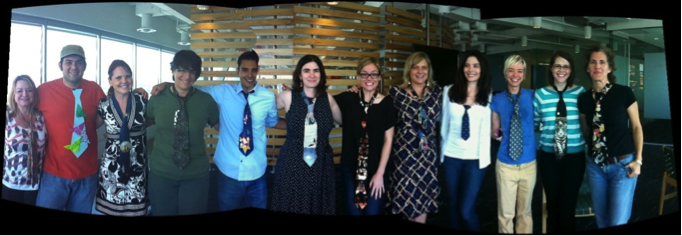In one month at my agency, SicolaMartin, we had… a talent show (the rappers won), an ugly tie contest in honor of Father’s Day, held a rooftop happy hour with a V8 Supercar driver (long story), toasted random Tuesday morning mimosas, hand delivered ice cream to employees (it was hot!), hosted a reunion so current and former Martians could swap stories, had an “Avengers” showing and enjoyed a watermelon keg while watching a co-worker kick off her new show for the Food Network’s YouTube channel, HUNGRY. And this is not a-typical. We like to have fun. And we do this on the clock. We’re not goofing off. We’re working.
Research out of California State University shows that “people who have fun at work are more creative, more productive, work better with others and call in sick less often.” And yet a William M. Mercer survey shows that “only 29 percent of employers nationwide encourage humor as part of their company culture, and only eight percent have a policy of using fun to reduce employee stress.”
That makes no sense to me. Fun is one of our core values; right alongside respect, honesty, passion and accountability.
We work incredibly hard. We are incredibly strategic and partner with our clients to produce award-winning work. But to keep producing exceptional work we must foster creativity. Which is why our art directors have a couple punching bags and an Xbox set up. It’s why we have Martians painted on the walls and an intranet named Uranus. When you are free to be open – to be silly – and not be judged, trust is established. And trust makes way for greater creative risks.
Tim Brown, the CEO of IDEO, gave a great TED Talk on “Creativity and Play”. One thing he talks about is how companies known for their innovation have a symbol of fun. Google has dinosaur statues on the lawn and Pixar employees have elaborate workstations. IDEO created a foam finger rocket.
At SicolaMartin we give everyone a collectable KidRobot Dunny. What this does is set the stage for every new Martian.
“Welcome to SicolaMartin. Here’s your toy.”
It gives permission to anyone joining the agency – from copywriters to accountants – that we’re here to enjoy what we do, enjoy each other and as a result create great work. Because at the end of the day, it’s still about the work. All the playfulness does is allow you to get to more creative solutions. Which is exactly what we’re hired to do.
Originally published July 2, 2012, on sicolamartin.com


